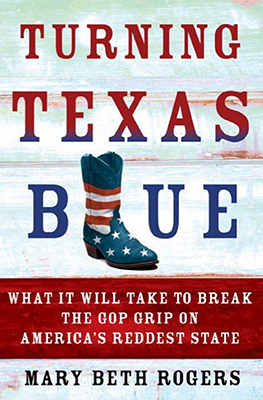 Michelle Newby is contributing editor at Lone Star Literary Life, reviewer for Foreword Reviews, freelance writer, member of the National Book Critics Circle, and blogger at www.TexasBookLover.com. Her reviews appear or are forthcoming in Pleiades Magazine, Rain Taxi, World Literature Today, South85 Journal, The Review Review, Concho River Review, Monkeybicycle, Mosaic Literary Magazine, Atticus Review, and The Collagist.
Michelle Newby is contributing editor at Lone Star Literary Life, reviewer for Foreword Reviews, freelance writer, member of the National Book Critics Circle, and blogger at www.TexasBookLover.com. Her reviews appear or are forthcoming in Pleiades Magazine, Rain Taxi, World Literature Today, South85 Journal, The Review Review, Concho River Review, Monkeybicycle, Mosaic Literary Magazine, Atticus Review, and The Collagist.
Lone Star Book Reviews
of Texas books appear weekly
at LoneStarLiterary.com
Mary Beth Rogers
Turning Texas Blue: What It Will Take to Break the GOP Grip on America’s Reddest State
St. Martin’s Press
Hardcover, 978-1250079084 (ebook also available), 256 pgs., $26.99
January 19, 2016
Mary Beth Rogers ran the last campaign that put a Democrat in the Texas governor’s mansion, the late Ann Richards. That was 1990. Since then Rogers, retired from the campaign trail, has watched aghast as “ordinary, business-oriented, conservative Republicans morph into crackpots and blustery buffoons” leaving “a path of political destruction and debris” in their wake. Fed up with waiting for the cavalry (“Democratic cleanup crew”) to arrive, Rogers studied the history of Texas politics, analyzed recent campaigns, and devised a ten-point plan to put Democrats back in state government. The result is Turning Texas Blue: What It Will Take to Break the GOP Grip on America’s Reddest State.
Combining amusing, occasionally snarky commentary with a firm grasp of the facts, Rogers addresses the numbers, strategy, and Big Themes, invoking Václev Havel, Twyla Tharp, Willie Nelson, and Royal Dutch Shell. She dissects the Battleground Texas experiment and the debacle of the Wendy Davis campaign. Rogers’s analysis is elementary for anyone who’s been paying attention but is a terrific primer for newcomers to the Texas political arena. Her history of the rise of the Republican Party in Texas (blame FDR, LBJ, Dallas, the Civil Rights Act of 1964, and Ronald Reagan) is comprehensive and engaging for veterans of the scene and new recruits alike. Rogers posits a theory that the election of Ann Richards and her push for inclusiveness actually helped to bring about the current state of affairs by challenging the status quo and the “most powerful economic interests in the state,” thereby sparking a backlash from traditional power bases. “The essence of conservative politics in modern life has always been to reclaim what is lost, or is about to be lost, if power slips away. That’s what happened in Texas in the 1990s. It has happened repeatedly since then.”
Rogers contends that what begins in Texas is the concern of the entire country because “there is something in the atmosphere here that convinces politicians that they should be president of the United States.” While she convincingly blames Texas for the Tea Party (Dick Armey) and Congressional gridlock due to gerrymandering (Tom DeLay), her assignment of responsibility for the Koch brothers (Karl Rove) is more tenuous, and the case for tort reform (“43”) draining Democratic coffers is an inspired conspiracy theory, even brilliant if true. Just because you’re paranoid doesn’t mean they aren’t out to get you. Also, No Child Left Behind education legislation ().
She gives Democrats hope by analyzing how Dallas, once the “most reactionary Republican city in Texas,” turned blue using microtargeting and invading areas once solidly red, such as suburbia, by intelligently utilizing new demographic trends. In the final chapter, Rogers writes a memorandum such as she used to write for Ann Richards, proposing a “New Texas Way” in ten steps and detailing how to achieve it. Turning Texas Blue will inspire weary, disillusioned Texas Democrats to don the armor again. And that’s an accomplishment.
* * * * *

